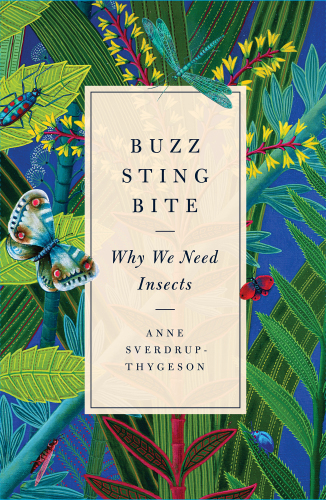
Extraordinary Insects
The Fabulous, Indispensable Creatures Who Run Our World
فرمت کتاب
ebook
تاریخ انتشار
2019
نویسنده
Anne Sverdrup-Thygesonناشر
Simon & Schusterشابک
9781982112899
کتاب های مرتبط
- اطلاعات
- نقد و بررسی
- دیدگاه کاربران
نقد و بررسی

May 20, 2019
Conservation biologist Sverdrup-Thygeson exudes an infectious enthusiasm for all things entomological in this curiosity-provoking primer. She presents a series of short, mostly self-contained, accounts of insect behavior, often emphasizing their connection to the larger world, grouped into such chapters as “Six-Legged Sex: Dating, Mating and Parenting,” “Eat or Be Eaten: Insects in the Food Chain,” and “From Silk to Shellac: Industries of Insects.” Moffatt’s translation readily conveys Sverdrup-Thygeson’s enjoyment of her subject, with playful and evocative descriptions and an amused tone—the long, bundled-up sperm of the male Drosophila bifurca fruit fly, at full length “20 times as long as the creature itself,” resembles “what happens when the kids make dinner and forget to put enough water into the spaghetti pan.” Stressing the sheer number of different insect species, she observes that entomologists have named newly discovered ones after pop music stars (the Beyoncé horsefly), and Harry Potter characters (the Ampulex dementor wasp). A short final chapter explicitly about conservation raises concerns while still maintaining a light touch. Sverdrup-Thygeson’s unforced humor and ability to quickly highlight salient information makes this a perfect selection for science-loving teenage readers as well as adults.

May 15, 2019
A fun introduction to the world of insects. They have existed for some 479 million years; have (mostly) six legs, four wings, two antennae, and a three-segment body; make up over half of known multicellular species; and number 200 million for every single human being living on the planet today. Indeed, we live on the planet of insects, and Sverdrup-Thygeson (Conservation Biology/Norwegian Univ. of Life Sciences) brings it to life in this sharp, good-humored presentation. Why are there so many insects? "Put simply: because they are small, supple, and sexy." It also helps that they can live nearly anywhere, including ice, hot springs, deep in caves, high on mountains, in baptismal fonts, and even your nostrils. The range of species runs from the tinkerbell wasp, which can land on the tip of a human hair and hardly make a disturbance, to the Chinese walking stick, which grows up to 2 feet in length. Insects are a fascinating topic, and the author milks their peculiarities for all they are worth: molting and metamorphosis, communication through scent, tasting with feet, seeing with knees, and listening through ears in their mouths. But the curios are only part of the bigger picture that situates insects in the great schemes of pollination, decomposition, soil formation, food for other creatures, keeping harmful organisms in check, dispersing seed, and even demonstrating solutions to problems that humans can adopt. In other words, insects could get along happily without humans, but humans could not survive without insects. The author's panoptic investigation keeps the narrative fully engaging as she alternates between anecdotes about specific insects--the aggressive mimicry of the spotted predatory katydid, the cicadas that "dig their way down--down into seventeen years of darkness"--to richly telling slices of science--e.g., the causes of decline in insect numbers. A classy and brightly informative appreciation of insects--all you could ask for in a popular natural history.
COPYRIGHT(2019) Kirkus Reviews, ALL RIGHTS RESERVED.

June 1, 2019
It's rare that we stop to consider the amazing world of insects, unless we swat a mosquito or briefly marvel at a butterfly. Sverdrup-Thygeson (conservation biology, Norwegian Univ. of Life Sciences) leads readers on a fascinating journey through the class Insecta, introducing us to the creatures whose numbers comprise half of the animal kingdom. Insects are ancient; they have survived all five mass extinction events. The author delves into insect anatomy and classification, reminding us that spiders, millipedes, mites, and daddy longlegs are not insects. Sverdrup-Thygeson continues by exploring the many fantastic characteristics of insects. They can see both ultraviolet and polarized light; they practice agriculture; they contain as much protein as beef, without the fat; and they help to solve crimes. Cockroaches can even be used to search for survivors in collapsed buildings. The dung beetle symbolized a god in ancient Egypt, but today our actions are threatening at least a quarter of all insects with extinction. We may not choose to worship insects, the author explains, but we should choose to protect them. VERDICT Appropriate for all readers, in particular those who are concerned about our planet and the creatures with which we share it.--Rachel Owens, Daytona State Coll. Lib., FL
Copyright 2019 Library Journal, LLC Used with permission.

June 1, 2019
Insects outnumber humans by billions, yet their lives and ecological importance often pass by unremarked. Sverdrup-Thygeson, a professor at the Norwegian University of Life Sciences, offers a lively introduction to the six-legged creatures that share our planet, while making the case that their survival is inextricably linked to ours. The author possesses an infectious enthusiasm for the bugs she profiles and manages to imbue every maxilla and mating habit with wonder. This book explores the basic elements that comprise an insect's life (what they are, what they eat, how they reproduce), marveling equally at the ingenuity of the bumblebee as at the medicinal value of the maggot. Insects decompose plant waste and return nutrients to the soil; they spin silk six times stronger than steel; and they offer models for scientists seeking to prolong life, enter stasis, and even break down human-created waste as fast as we produce it. Ably translated by Moffatt, Buzz, Sting, Bite will foster affection for its winged, creeping, and crawling subjects, even among its most bug-shy readers.(Reprinted with permission of Booklist, copyright 2019, American Library Association.)

























دیدگاه کاربران